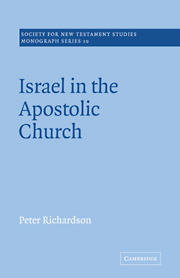Book contents
- Frontmatter
- Contents
- Preface
- Introduction
- Texts and Abbreviations
- I THE CHURCH AND ISRAEL
- II THE CHURCH FATHERS TO A.D. 160
- III POLITICAL FACTORS IN THE SEPARATION
- IV JESUS AND HIS DISCIPLES
- V PAUL
- VI POST-PAULINE DEVELOPMENTS
- VII CONCLUDING SUMMARY
- APPENDIXES
- A The ‘Apology’ of Aristides
- B Paul's use of λαός
- C The sects of Judaism and ‘ true Israel’
- INDEXES
C - The sects of Judaism and ‘ true Israel’
Published online by Cambridge University Press: 05 March 2010
- Frontmatter
- Contents
- Preface
- Introduction
- Texts and Abbreviations
- I THE CHURCH AND ISRAEL
- II THE CHURCH FATHERS TO A.D. 160
- III POLITICAL FACTORS IN THE SEPARATION
- IV JESUS AND HIS DISCIPLES
- V PAUL
- VI POST-PAULINE DEVELOPMENTS
- VII CONCLUDING SUMMARY
- APPENDIXES
- A The ‘Apology’ of Aristides
- B Paul's use of λαός
- C The sects of Judaism and ‘ true Israel’
- INDEXES
Summary
The writings of Palestinian Judaism from the mid-second century B.C. to the late first century A.D. often reflect party points of view. An exclusivist tendency within Judaism nearly always involves the implication that the particular group represented ‘Israel’. Redefinition of the term ‘Israel’, however, goes back at least to the time of the return from exile and probably beyond. As time went on, and under the impulse of the Maccabean struggle, these divisions become sharper, so that, whereas before the majority of Jews were probably agreed upon the constitution of ‘Israel’, later each party tends to call the other outcast, and to identify itself with the purified remnant.
There is great uncertainty in basic matters of milieu, date, purpose, composition of the writings mentioned below. Entangling the necessarily brief discussion with matters such as these must be avoided in favour of simply assessing how a sect or party thought of itself in terms of the whole in relation to others.
First Maccabees is concerned with the general separation between nationalists and hellenists. The attitude found here is passed on with increasing bitterness to all the successor parties. For our purposes the most important feature of i Maccabees is its demonstration of the way a segment of Judaism can be sloughed off as no longer belonging to Israel. The association of ex Israel with a term of abuse in many phrases underlines the exclusion which adherence to a wrong point of view brings. By failing to circumcise their children (i: 48; 1: 15) the hellenists completed their own separation from Israel, becoming in the process identified with the Gentiles (chapter i, especially 1: 15).
- Type
- Chapter
- Information
- Israel in the Apostolic Church , pp. 217 - 228Publisher: Cambridge University PressPrint publication year: 1969

